Lacquerware
Lacquerware are objects decoratively covered with lacquer. Lacquerware includes small or large containers, tableware, a variety of small objects carried by people, and larger objects such as furniture and even coffins painted with lacquer. Before lacquering, the surface is sometimes painted with pictures, inlaid with shell and other materials, or carved. The lacquer can be dusted with gold or silver and given further decorative treatments.
_with_Dragon_amid_Clouds_LACMA_M.83.148.1.jpg)
East Asian countries have long traditions of lacquer work, going back several thousand years in the cases of China and Japan. The best known lacquer, an urushiol-based lacquer common in East Asia, is derived from the dried sap of Toxicodendron vernicifluum. Other types of lacquers are processed from a variety of plants and insects. The traditions of lacquer work in Southeast Asia and the Americas are also ancient and originated independently. True lacquer is not made outside Asia, but some imitations, such as Japanning in Europe, or parallel techniques, are often loosely referred to a "lacquer."
East Asia
Various prehistoric lacquerwares have been unearthed in China dating back to the Neolithic period and objects with lacquer coating found in Japan dating to the late Jōmon period.[1] The earliest known lacquer object was thought to be a red wooden bowl, which was unearthed at a Hemudu culture (c. 5th millennium BC) site in Zhejiang, China.[2][3][4] However, older lacquer wares, burial ornaments which were created in 7th millennium century B.C., were unearthed at Kakinoshima-remains in Hakodate, Hokkaido, Japan.
Chinese lacquerware
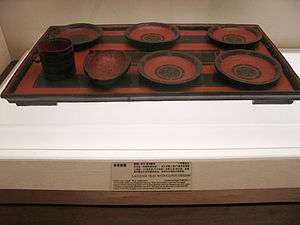
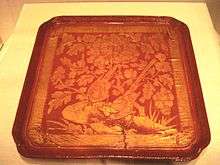
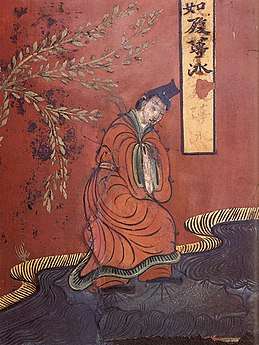
During the Shang dynasty (ca. 1600–1046 BC) of China, sophisticated lacquer process techniques developed became a highly artistic craft.[1]
During the Eastern Zhou period (771–256 BC), lacquerware began appearing in large quantity. This is the earliest era from which notable quantities of lacquerware have survived.[5]
At the time of the Han dynasty (206 BC – 220 AD), special administrations were established to organize and divide labor for the expanding lacquer production in China.[6] Elaborate incised decorations were used in lacquerware during the Han dynasty.[7]
In the Tang dynasty (618–907), Chinese lacquerware saw a new style marked by the use of sheets of gold or silver made in various shapes, such as birds, animals, and flowers.[6] The cut-outs were affixed onto the surface of the lacquerware, after which new layers of lacquer were applied, dried, and then ground away, so the surface could be polished to reveal the golden or silvery patterns beneath.[6] This was done by a technique known as pingtuo.[8] Such techniques were time-consuming and costly, but these lacquerware were considered highly refined.[6] It was also the period when the earliest practice of carving lacquerware began.[9]
The art of inlaid gold, silver, and mother-of-pearl continued from the Tang into the Song dynasty (960–1279).[10] Several existing decorative techniques gradually developed further after the 10th century, such as diaoqi (carved lacquer) which involves building up layers comprising thinly-applied coats of lacquer and carving it into a three-dimensional design; qiangjin (engraved gold) in which fine lines are incised, an adhesive of lacquer is applied, and gold foil or powder is pressed into the grooves; and diaotian or tianqi (filled-in) in which the lacquer is inlaid with lacquer of another color.[7] A variation of diaotian or tianqi is known as moxian (polish-reveal) in which a design is built up with lacquer in certain areas, the remaining areas are filled with lacquer of a different color, and the entire surface is polished down.[7] Especially the art of inlaying lacquer with mother-of-pearl was intensively developed during the Song dynasty.[7][10] However, during the Song, the artistic craft also made use of inlaid gold in a process of which is to engrave intricate patterns in the lacquer surface and to fill the intaglio with gold powder.[6]
The knowledge of the Chinese methods of the lacquer process spread from China during the Han, Tang and Song dynasties,[11] eventually it was introduced to Korea, Japan, Southeast and South Asia.[11] In Japan, the art of lacquerware-making came along with Buddhism and other cultural artifacts from China via the Korean Peninsula during the 8th century,[12] and carved lacquerware came to Japan from Ming dynasty China during the 14th century.[12] One of the earliest Japanese techniques for decorating the lacquer surface was, besides painting simple designs, the gold and silver foil inlay of the Nara period (710–784). This technique was transmitted from China during the Tang dynasty.[7]
Coromandel lacquer is a Chinese export type, so called because it was shipped to European markets via the Coromandel coast of India.
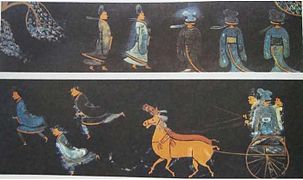
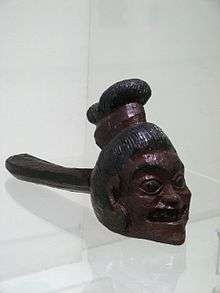 Lacquerware in the shape of a man's head, Western Han (202 BC – 9 AD), Yunnan Provincial Museum, Kunming
Lacquerware in the shape of a man's head, Western Han (202 BC – 9 AD), Yunnan Provincial Museum, Kunming_with_Scrolling_Clouds_and_Supernatural_Creatures_LACMA_AC1997.50.1.1-.2.jpg) Lidded cosmetic box, Western Han dynasty, about 100 BC – 25 AD
Lidded cosmetic box, Western Han dynasty, about 100 BC – 25 AD- Painted lacquerware dish from the tomb of Zhu Ran (182–249 AD) in Anhui province, showing figures wearing Hanfu, Eastern Wu period
 A lacquered table of the Yuan dynasty, 14th century, with an inlaid mother-of-pearl decoration of a tree
A lacquered table of the Yuan dynasty, 14th century, with an inlaid mother-of-pearl decoration of a tree_with_Sword-Pommel_Pattern_LACMA_M.84.121.1a-b.jpg) Carved lacquer box with the "Sword-Pommel Pattern", Yuan dynasty (1279–1368)
Carved lacquer box with the "Sword-Pommel Pattern", Yuan dynasty (1279–1368)- Box, Ming dynasty, Yongle era (1403–1424)
_with_Sword-Pommel_Pattern_LACMA_M.79.89.1.jpg) Carved lacquer stem cup with the "Sword-Pommel Pattern", mid-Ming dynasty
Carved lacquer stem cup with the "Sword-Pommel Pattern", mid-Ming dynasty_with_Figure_on_Horse_LACMA_M.39.2.569.1.jpg) Square dish, Qing dynasty, Kangxi era (1662–1722)
Square dish, Qing dynasty, Kangxi era (1662–1722)
Japanese lacquerware
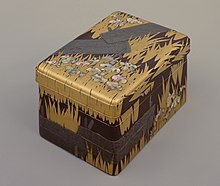
Lacquerware is referred to by the Sinitic compound shikki (漆器) in Japanese. The native term for lacquer is urushi (漆), source of the English hybrid word "urushiol". Etymologically, urushi may be related to the words uruwashii ("beautiful") or uruoi ("watered", "profitable", "favored"), due speculatively to their value or shiny appearance, or perhaps the humidifying rooms used in production of lacquered wares.
The general characteristic of Japanese lacquerware is the widespread use of various Maki-e techniques compared to other countries. As a result, there are many works in which relatively vivid gold and silver patterns and pictures shine on the black base of lacquerware, and the entire lacquerware is covered with shiny gold and silver grains.
The 17th-century term "japanning" refers to a range of techniques to imitate various Asian lacquerware, but especially those developed in Europe and Great Britain to resemble lacquerware imported from the Orient. These commonly employed a black, oil-based varnish ("Japan black", "Brunswick black", etc.) on wood and later metal substrates, eventually finding a variety of 19th- and early-20th-century industrial applications. Japan black was famously Ford's preferred automotive finish until the advent of quick-drying, variously colored nitrocellulose lacquers.
History and regional production
Primitive lacquer was used in Japan as early as 12,600 BC, during the Jōmon period.[13][14]
Lacquer was used in Japan as early as 7000 BCE, during the Jōmon period. Evidence for the earliest lacquerware was discovered at the Kakinoshima "B" Excavation Site in Hokkaido.[15] These objects were discovered in a pit grave dating from the first half of the Initial Jōmon period (approx. 9,000 years ago)[13][14]
Some lacquerware basic techniques also arrived in Japan from China through the Korean Peninsula along with Buddhism and the Chinese writing system in the Asuka and Nara periods (6th through 8th centuries).
_Design_of_wheels-in-stream.jpg)
In the Heian period (794-1185), various Maki-e techniques characteristic of Japanese lacquerware were developed. While the method of drawing designs with a brush by dissolving gold powder in lacquer is a common technique in other countries, the method of drawing designs with lacquer and then sprinkling gold, silver, or copper powder of various sizes and shapes on top to polish them was developed in Japan. This made it possible to make the gold and silver of lacquerware brighter than before.[16]
By the Kamakura period (1185–1333), Japanese craftsman under the influence of the Song dynasty arts focused on carving Buddhist imagery into thick coats of lacquer (Kamakura-bori). Japanese craftsman at this time began applying a thin lacquer coat to carved wood substrates, in this way reducing production times and making lacquerware available beyond temples to samurai and merchants.
In the Azuchi-Momoyama period (1568-1600), Japanese lacquerware was exported to Europe by Nanban trade. Japanese lacquerware attracted missionaries from Europe, and western style chests and church furniture were exported in response to their requests.[17]

The Edo period (1603–1868) saw an increase in the focused cultivation of lacquer trees and the development of the techniques used. In the 18th century colored lacquers came into wider use. With the development of economy and culture, the artistic quality of lacquered furniture has improved. Hon'ami Kōetsu and Ogata Kōrin brought the designs of the Rinpa school of painting into lacquerware. After the middle of the Edo period, inro became popular as men's accessories, and wealthy merchants of the chōnin class and samurai class collected inro of high aesthetic value, precisely designed with lacquer.[18][19] Marie Antoinette and Maria Theresa are known collectors of Japanese lacquerware and their collections are now often exhibited in the Louvre and the Palace of Versailles.[16]

In the Meiji period (1868-1912), Richly-decorated lacquerwares in original designs were popular domestically, and even more so with Western buyers during this period of European and American fascination with Japanese art. Shibata Zeshin's lacquer work was especially popular.[20] In addition, lacquerware called Shibayama and Somada, which were created in the Edo period, became popular for its showy style, inlaid with gold, silver, shellfish, ivory, and colorful metal and glass, and reached its peak during this period.[21] The government took an active interest in the art export market, promoting Japan's lacquers and other decorative arts at a succession of world's fairs.[22][23] Lacquer from Japanese workshops was recognised as technically superior to what could be produced anywhere else in the world.[24]
Today, lacquerware is produced throughout the Japanese archipelago, with many regional techniques and variations. Besides the very old Kamakura tradition mentioned above (and still alive today), the port town of Wajima provides a good example of regional lacquerware. Wajima-nuri, dating back to the 16th century, is characterized by use of the elm-like Japanese zelkova (keyaki 欅), powdered earth, and delicate features formed from cloth. (See the Japanese article, 輪島塗. A more complete list of regional lacquer traditions is available in the Japanese article.)
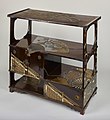 Tiered Stand with Designs Alluding to The Tale of Genji, by Hon'ami Kōetsu, 17th century
Tiered Stand with Designs Alluding to The Tale of Genji, by Hon'ami Kōetsu, 17th century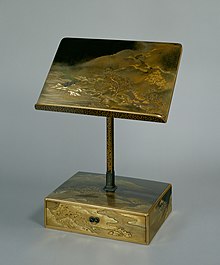 Reading Stand with Mount Yoshino
Reading Stand with Mount Yoshino Stationery Stand Morning sun, paulownia and phoenix in maki-e
Stationery Stand Morning sun, paulownia and phoenix in maki-e Lacquered exterior of Tantō Norishige.
Lacquered exterior of Tantō Norishige. Saddle and Stirrups with Wisterias
Saddle and Stirrups with Wisterias
Ryukyuan lacquerware
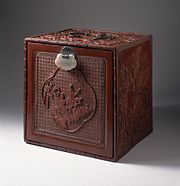
Ryukyuan lacquerware is one of the chief artistic products of the Ryukyu Islands (today Okinawa Prefecture of Japan); it is quite distinct from the lacquerware found among the surrounding cultures. Nevertheless, Chinese and Japanese influences are present.
Southeast Asia
Burmese lacquerware
Yun-de is lacquerware in Burmese, and the art is called Pan yun (ပန်းယွန်း). The lacquer is the sap tapped from the varnish tree or Thitsee (Gluta usitata, syn. Melanorrhoea usitata) that grows wild in the forests of Myanmar (formerly Burma).[25] It is straw-colored but turns black on exposure to air. When brushed in or coated on, it forms a hard glossy smooth surface resistant to a degree from the effects of exposure to moisture or heat.
History
Bayinnaung's conquest and subjugation in 1555–1562 of Manipur, Bhamo, Zinme (Chiang Mai), Linzin (Lan Xang), and up the Taping and Shweli rivers in the direction of Yunnan brought back large numbers of skilled craftsmen into Burma. It is thought that the finer sort of Burmese lacquerware, called Yun, was introduced during this period by imported artisans belonging to the Yun or Laos Shan tribes of the Chiang Mai region.[26]
Manufacture and design
Lacquer vessels, boxes and trays have a coiled or woven bamboo-strip base often mixed with horsehair. The thitsee may be mixed with ashes or sawdust to form a putty-like substance called thayo which can be sculpted. The object is coated layer upon layer with thitsee and thayo to make a smooth surface, polished and engraved with intricate designs, commonly using red, green and yellow colors on a red or black background. Shwezawa is a distinctive form in its use of gold leaf to fill in the designs on a black background.[27][28]
Palace scenes, scenes from the Jataka tales, and the signs of the Burmese Zodiac are popular designs and some vessels may be encrusted with glass mosaic or semi-precious stones in gold relief.[28] The objects are all handmade and the designs and engraving done free-hand. It may take three to four months to finish a small vessel but perhaps over a year for a larger piece. The finished product is a result of teamwork and not crafted by a single person.[27]
Forms
The most distinctive vessel is probably a rice bowl on a stem with a spired lid for monks called hsun ok. Lahpet ok is a shallow dish with a lid and has a number of compartments for serving lahpet (pickled tea) with its various accompaniments. Stackable tiffin carriers fastened with a single handle or hsun gyaink are usually plain red or black. Daunglan are low tables for meals and may be simple broad based or have three curved feet in animal or floral designs with a lid. Water carafes or yeidagaung with a cup doubling as a lid, and vases are also among lacquerware still in use in many monasteries.[27][28]
Various round boxes with lids, small and large, are known as yun-it including ones for paan called kun-it (Burmese: ကွမ်းအစ်; betel boxes). Yun titta are rectangular boxes for storing various articles including peisa or palm leaf manuscripts when they are called sadaik titta. Pedestal dishes or small trays with a stem with or without a lid are known as kalat for serving delicacies or offering flowers to royalty or the Buddha. Theatrical troupes and musicians have their lacquerware in costumes, masks, head-dresses, and musical instruments, some of them stored and carried in lacquer trunks.[28] Boxes in the shape of a pumpkin or a bird such as the owl, which is believed to bring luck, or the hintha (Brahminy duck) are common too. Screens and small polygonal tables are also made for the tourist trade today.
Industry
Bagan is the major centre for the lacquerware industry where the handicraft has been established for nearly two centuries, and still practiced in the traditional manner. Here a government school of lacquerware was founded in the 1920s. Since plastics, porcelain and metal have superseded lacquer in most everyday utensils, it is today manufactured in large workshops mainly for tourists who come to see the ancient temples of Bagan. At the village of Kyaukka near Monywa in the Chindwin valley, however, sturdy lacquer utensils are still produced for everyday use mainly in plain black.[27]
A decline in the number of visitors combined with the cost of resin, which has seen a 40-fold rise in 15 years, has led to the closure of over two-thirds of more than 200 lacquerware workshops in Bagan.[29]
Vietnamese lacquer painting
Sơn mài is a painting technique in Vietnam. It developed from the painters of the Hanoi EBAI in the 1930s and today is counted a national painting style with many famous painters.
In 1924 the Ecole des Beaux Arts was established in Hanoi. This institution was to be the birthplace of the revitalised art of lacquer painting. In 1934 the school opened its lacquer department and it was from here that such luminaries of the art as; Bui Trang Chuoc, Nguyen Van Binh, Nguyen Khang, Nguyen Duc Nung, Nguyen Tien Chung, and Pham Van Don would emerge.
It was the first generation of Vietnamese students of the Indochina School of Fine Art during the 1930s, who elevated the craft of lacquer painting to a truly fine art. Less interested in decor than their craftsmen predecessors, it was also these men who would begin a series of artistic innovations from which craftsmen producing purely utilitarian or decorative pieces would also benefit.
Creating images with crushed eggshell, painting pigment over gold and tin foil and adding sand to lacquer were all techniques developed by those first students. The metallic color lacquerware for which Vietnamese craftsmen are rightly famous, was first developed by artists experimenting with many innovative techniques.
After the reunification, the art of lacquerware was slowly dying out in Vietnam. But since the 1980s, the government has recognized it as a vital cultural and economic force and has encouraged the business community to invest in the craft. As a result, we see a resurgence of lacquerware and a proliferation of lacquerware products from Vietnam.
Americas
Barniz de Pasto technique
Barniz de Pasto (es) is a lacquer-like varnish technique originating in the Pre-Columbian era that is a specialty of Pasto, Colombia. It is made by chewing the resin of the Andean mopa-mopa shrub (Elaeagia pastoensis) into thin layers, and then painting it and applying it to a wood, metal, clay or glass surface using heated stones.[30][31] Historically, the technique was applied to wooden keros, drinking vessels.
Mexican lacquerware
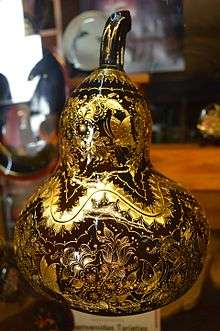
Known in Mexican Spanish as laca or maque (from Japanese maki-e[32]), Mexican lacquer has independent origins from Asian lacquer. In the pre-Hispanic period, a substance from the aje larvae and/or oil from the chia seed were mixed with powdered minerals to create protective coatings and decorative designs. During this period, the process was almost always applied to dried gourds, especially to make the cups that Mesoamerican nobility drank chocolate from.
After the Conquest, the Spanish had indigenous craftsmen apply the technique to European style furniture and other items, changing the decorative motifs and color schemes, but the process and materials remained mostly the same. Asian lacquerware and artisans brought by the Nao de China also had an influence on the style and motifs of colonial Mexican lacquerware. Today, workshops creating lacquerware are limited to Olinalá, Temalacatzingo and Acapetlahuaya in the state of Guerrero, Uruapan and Pátzcuaro in Michoacán and Chiapa de Corzo in Chiapas. The most popular modern lacquerware are small boxes, sometimes known as cajitas de Olinalá.
References
- Webb, Marianne (2000). Lacquer: Technology and conservation. Oxford: Butterworth-Heinemann. p. 3. ISBN 978-0-7506-4412-9.
- Fung, Christopher (1994). "The Beginnings of Settled Life". China: Ancient Culture, Modern Land. Norman: University of Oklahoma Press. p. 52. ISBN 9780806126838.
- Li, Li (2011). China's Cultural Relics (3rd ed.). Cambridge: Cambridge University Press. pp. 139–140. ISBN 9780521186568.
- Bagley, Robert (1999). "Shang Archaeology". The Cambridge History of Ancient China: From the Origins of Civilization to 221 B.C. Cambridge: Cambridge University Press. p. 178. ISBN 9780521470308.
- Kleiner, Fred S. Gardner's Art Through The Ages: A Global History (14th ed.). Boston: Wadsworth, Cengage Learning. p. 995. ISBN 9780840030597.
- Hang, Jian; Guo, Qiuhui (2006). Chinese arts & crafts. Translated by Zhu, Youruo; Song, Peiming. Beijing: China Intercontinental Press. pp. 54–58. ISBN 978-7-5085-0963-1.
- "Lacquerware of East Asia". The Metropolitan Museum of Art. Retrieved 21 September 2011.
- Watt, James C. Y.; Ford, Barbara Brennan (1991). East Asian lacquer : the Florence and Herbert Irving Collection. New York: Metropolitan Museum of Art. pp. 20–21. ISBN 9780870996221.
- Webb, Marianne (2000). Lacquer: Technology and Conservation. Oxford: Butterworth-Heinemann. p. 42. ISBN 9780750644129.
- Watt, James C. Y.; Ford, Barbara Brennan (1991). East Asian lacquer : the Florence and Herbert Irving Collection. New York: Metropolitan Museum of Art. p. 23. ISBN 9780870996221.
- Institute of the History of Natural Sciences and Chinese Academy of Sciences, ed. (1983). Ancient China's technology and science. Beijing: Foreign Languages Press. p. 211. ISBN 978-0-8351-1001-3.
- Akio Haino. "Chinese Carved Lacquerware". Kyoto National Museum. Retrieved 2007-08-16.
- 1万2千年前のウルシ木片 世界最古、福井で出土, The Nikkei, November 6, 2011
- Kakinoshima Jomon Archaeological Site
- Hokkaido's Minamikayabe Town, Kakinoshima Site B (北海道の南茅部町の垣ノ島B遺跡)
- Masayuki Murata. 明治工芸入門 p.24. Me no Me, 2017 ISBN 978-4907211110
- Urushi once attracted the world urushi-joboji.com
- Masayuki Murata. 明治工芸入門 p.104. Me no Me, 2017 ISBN 978-4907211110
- Yūji Yamashita. 明治の細密工芸 p.80. Heibonsha, 2014 ISBN 978-4582922172
- Earle 1999, pp. 186–187.
- Yūji Yamashita. 明治の細密工芸 pp.60-61. Heibonsha, 2014 ISBN 978-4582922172
- Earle 1999, pp. 30–31.
- Liddell, C. B. (2013-12-14). "[Review:] Japonisme and the Rise of the Modern Art Movement: The Arts of the Meiji Period". The Japan Times. Retrieved 2020-03-19.
- Earle 1999, p. 187.
- "Melanorrhoea usitatissima". die.net online dictionary. Retrieved 2007-03-31.
- D.G.E. Hall (1960). Burma. Hutchinson University Library. p. 42.
- Blurton, Richard (2002). "A Path to Burmese Culture: The Art of Lacquer". The British Museum/Fathom. Archived from the original on 2007-04-04. Retrieved 2007-03-31.
- "Burmese Lacquerware Collection". Art Only. 2006. Archived from the original on September 30, 2007. Retrieved 2007-03-31.
- Kyi Wai. "Burmese Lacquerware Loses Its Shine". The Irrawaddy, January 19, 2009. Archived from the original on August 11, 2010. Retrieved 2009-03-19.
- "Crafts of Pasto". Spanish in Colombia. MinCultura. Retrieved 27 February 2017.
- Brown, Michael A.; Frick, Julie Wilson. "Exhibit Explores Prized Functional Items in Spanish America". Denver Art Museum. Retrieved 22 July 2014.
- Roberts, Edward A. (2014). A Comprehensive Etymological Dictionary of the Spanish Language with Families of Words based on Indo-European Roots. Xlibris Corporation. p. 170. ISBN 9781493191130. Retrieved 19 May 2017.
Further reading
- East Asian lacquer: the Florence and Herbert Irving collection. New York: The Metropolitan Museum of Art. 1991.
- Japanese Lacquer, 1600–1900: selections from the Charles A. Greenfield collection. New York: The Metropolitan Museum of Art. 1980.
- Kawai, K.; Nakagawa, M.; Kawai, K.; Miyakoshi, T.; Miyashita, K.; Asami, T. (1992). "Heat treatment of Japanese lacquerware renders it hypoallergenic". Contact Dermatitis. 27 (4): 244–9. doi:10.1111/j.1600-0536.1992.tb03254.x. PMID 1451490.
- Kawai, K.; Nakagawa, M.; Kawai, K.; Liew, F. M.; Yasuno, H. (1991). "Hyposensitization to urushiol among Japanese lacquer craftsmen: results of patch tests on students learning the art of lacquerware". Contact Dermatitis. 25 (5): 290–5. doi:10.1111/j.1600-0536.1991.tb01876.x. PMID 1839723.
- Earle, Joe (1999). Splendors of Meiji : treasures of imperial Japan : masterpieces from the Khalili Collection. St. Petersburg, Fla.: Broughton International Inc. ISBN 1874780137. OCLC 42476594.CS1 maint: ref=harv (link)
External links
| Wikimedia Commons has media related to Lacquerware. |
- "Lacquerware Stories" at the Kyoto National Museum.
- Museum of Lacquer Art Münster Museum für Lackkunst in Germany
- The Craft and Care of East Asian Lacquer by Denver Art Museum
- Bone, Flesh, Skin: the making of Japanese Lacquer YouTube video by Getty Museum
- Intro to Urushi YouTube video by Dr.Kenji Toki at FabLabKamakura
- Lacquerware of East Asia essay at the MET Museum